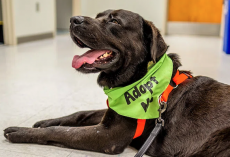Need to train your dog how to walk politely on a leash?
Walks aren’t just for exercise — they’re a bonding moment, a confidence booster and the perfect chance to sneak in some training while having fun. Here’s how to make leash training smooth, positive and frustration-free.
What Is Leash Training?
Leash training teaches your dog how to behave politely while wearing — or even just being near — a leash. It usually includes:
- Getting your dog comfortable with a leash and collar or harness
- Building impulse control and basic heelwork
- Teaching her not to chew, tug or drag you down the street
Why Leash Training Matters
A well-behaved dog on walks isn’t just nice — it’s essential for her safety and your sanity. (We’ve all seen someone getting dragged down the sidewalk … let’s not be that person.)
Start early:
You can begin introducing leash equipment around 8 weeks old, and once your pup is fully vaccinated (around 16–18 weeks), you can safely start outdoor walks.
If your dog’s older? No problem. Older pups can absolutely learn good leash manners — you may just have to undo some old habits with a little extra patience.
Choosing the Best Leash & Harness
Good equipment makes training so much easier — and safer.
Use a no-pull harness
A front-clip harness gives you more control and reduces strain on your dog’s neck. Collars should only be used for ID tags or for dogs already trained to walk on a loose leash.
For large or strong pullers, a head halter – also known as a gentle leader (like the Halti head collar) might help — but talk to your trainer first.
Like the Tru-Fit Smart Dog Walking Harness from Kurgo
Skip the retractable leash
Retractable leashes create constant pressure, which actually teaches your dog to pull. Instead, choose a sturdy 4–6 ft. non-retractable nylon leash.
Like this Nylon Dog Leash from Amazon
Introducing Your Dog to Their Gear
If your dog’s never worn a collar or harness, take it slow:
- For collars: Put it on loosely indoors and make it positive — play games, give treats.
- For over-the-head harnesses: Lure your dog’s head through with a treat, reward and don’t rush it.
- For step-in harnesses: Encourage your pup to walk into it with a big treat, then buckle it as she munches.
Avoid forcing or manhandling your dog into gear — that only builds negative associations.
Let her walk around indoors in the new equipment, rewarding often. Make the first impressions great.
How To Leash Train Step-By-Step
1. Let your dog get used to a leash
Start with a short dragline (about 1 ft) — a leash without a handle — so it won’t catch on things. Let her drag it around indoors to get familiar with the feeling.
You can try this Nylon Drag Leash from Amazon
2. Teach “sit before leashing”
Impulse control = better leash manners.
- Hold the leash.
- Wait (silently!) for your pup to sit on her own.
- If she stays sitting, slowly lean down to clip the leash.
- If she pops up, stand straight and try again.
Avoid giving cues — you want her to choose calmness.
3. Prevent leash chewing with a strong “drop it”
Start by teaching “drop it” using a rope toy:
- Drag the toy and say “get it.”
- Play tug (side-to-side, not up-and-down).
- Freeze the toy, say “drop it” and wait.
- When she drops it, bring it back to life and say “get it.”
- Repeat three times.
Practice once a day for a month. Then transfer the behavior to the leash if she tries chewing it.
This teaches that “drop it” doesn’t mean “fun is over” — just “switch to something else.”
4. Teach your dog to walk at your side (heelwork)
- Hold a treat in front of her nose.
- Move your arm around to guide her to your side.
- When she’s next to you and facing forward, click and reward.
This builds focus and helps her ignore distractions like cars, squirrels or other dogs.
Common Leash-Walking Problems (And Fixes)
If she pulls forward
Stop immediately.
Wait for her to stop, lure her back to your side, and resume walking.
Reward often when she’s walking nicely.
If she drags you to a smell or dog
Stop.
Say her name.
When she checks in with you, reward.
Then let her sniff or say hi if you choose to — you’re the one in control.
If she lags dramatically behind
Don’t turn around or coax.
Wait 20–30 seconds.
If she moves on her own, praise like crazy.
If not, lure her forward a few steps, then reward.
If she switches sides constantly
Pick one side and stick to it.
If she crosses over, stop and lure her back.
Praise generously when she stays on the correct side.
With some patience and consistency, leash training becomes an enjoyable part of your daily routine — and one of the best bonding moments you’ll share.
We independently pick all the products we recommend because we love them and think you will too. If you buy a product from a link on our site, we may earn a commission.











